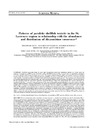Identificador persistente para citar o vincular este elemento:
https://accedacris.ulpgc.es/jspui/handle/10553/50857
| Título: | Patterns of paralytic shellfish toxicity in the St. Lawrence region in relationship with the abundance and distribution of Alexandrium tamarense | Otros títulos: | Pautas de intoxicación paralítica de moluscos en la región Canadiense del río San Lorenzo: Relación con abundancia y distribución de Alexandrium tamarense | Autores/as: | Blasco, Dolors Levasseur, Maurice Bonneau, Esther Gelinas, Roger Packard, T. T. |
Clasificación UNESCO: | 2302 Bioquímica 251001 Oceanografía biológica |
Palabras clave: | Red tides Harmful algal blooms Dinoflagellate Phytoplankton PSP, et al. |
Fecha de publicación: | 2003 | Editor/a: | 0214-8358 | Publicación seriada: | Scientia Marina | Resumen: | Shellfish toxin data from 11 years and Alexandrium tamarense abundance during 6 of those years are analysed. Comparison of PSP toxicity in Mytilus edulis with PSP toxicity in Mya arenaria shows a significant correlation (r2=0.61), with M. edulis being five times more toxic. The results support using M. edulis as a sentinel species for shellfish toxicity in the St. Lawrence region. High interannual variability was found in the PSP and A. tamarense data, but no trends were manifest. Correlation analysis revealed clearly defined geographical station groups. These groups were characterised by seasonal distributions and outbreak times, and were associated with the surface seawater circulation. The results indicate blooms spreading from the open Gulf, upstream toward the Estuary. Since the spring bloom also spreads upstream, we hypothesise that the A. tamarense bloom is just one of the steps in the traditional phytoplankton succession diatoms-dinoflagellates-small flagellates, which is controlled by the classic oceanographic processes of nutrient depletion and water column stratification. A. tamarense distribution over the entire sampled area was similar to the PSP toxicity in M. edulis. In 1993, 59% of PSP variability was explained by A. tamarense. Furthermore, mussel toxin rises with increasing A. tamarense concentration. Shellfish contamination starts as soon as A. tamarense is present in the water. In addition, detoxification starts when A. tamarense decreases below the level of detection. However, the most important finding of this study is that only 1000 A. tamarense cells per litre are sufficient to raise the toxin in the mussels to the level (80 µg STX eq/100 g tissue) at which the closure of shellfish harvesting activities is obligatory. | URI: | https://accedacris.ulpgc.es/handle/10553/50857 | ISSN: | 0214-8358 | DOI: | 10.3989/scimar.2003.67n3261 | Fuente: | Scientia Marina [ISSN 0214-8358], v. 67, p. 261-278 |
| Colección: | Artículos |
Citas SCOPUSTM
29
actualizado el 08-jun-2025
Citas de WEB OF SCIENCETM
Citations
28
actualizado el 08-jun-2025
Visitas
120
actualizado el 31-oct-2024
Descargas
102
actualizado el 31-oct-2024
Google ScholarTM
Verifica
Altmetric
Comparte
Exporta metadatos
Los elementos en ULPGC accedaCRIS están protegidos por derechos de autor con todos los derechos reservados, a menos que se indique lo contrario.
